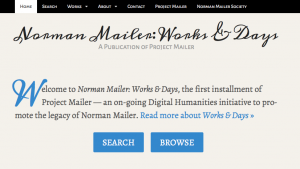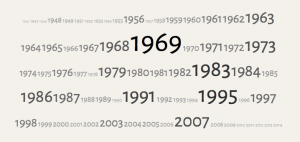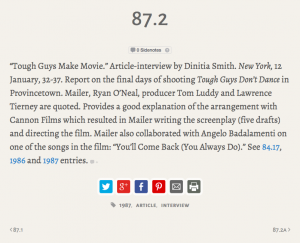Norman Mailer: Works and Days/Project Introduction
Gerald R. Lucas
In the Spring of 2014, Mike Lennon and I had lunch at a small café in Atlanta and talked about the future.[1]
I had been acting as the voice and advocate of the digital life of the Norman Mailer Society since I joined in 2006. Even before that, my interests and research were catalyzed by the nascent digital world. My graduate work centered on the pinnacle of print culture — literary studies — but simultaneously I dabbled in the revolutionary world of the digital. I spent frustrating hours trying to make my university network account work on my ancient Macintosh Classic through its 28.8K dial-up connection — fast for the early nineties. My first reaches through cyberspace were limited to a text-based terminal, through which I was introduced to the robust powers of w:UNIX that seemed light-years behind my Mac’s GUI, yet somehow much stronger, like the difference between a Toyota Tercel and a Mercedes diesel sedan. After earning my M.A., my upgraded 56K modem and the university’s new Point-to-Point Protocol (PPP) fit the Internet to my Mac. Mosaic suddenly opened up my small studio apartment to the World Wide Web and its promise, and I have never looked back.
I learned HTML and began to publish my own resources on the Web, like syllabi, experimental hypertexts, and my own personal Web sites. The early Web was like a rough frontier with digital pioneers staking their own settlements in a wild land, but one that, even then, held the promise of a new space that would lead to its own democracy, community, and culture. The years after 1999 would bring inexpensive high-speed access, search engines and aggregators, and the Web 2.0, changing the practice of digital publication from individuals on university servers and dial-up hosts to larger initiatives based on a communal interests. Suddenly those of us who wanted to express ourselves on the Web no longer needed to think about programming languages, hosting, FTP, and HTML. Web 2.0 platforms brought together communities of users who shared a common interest or goal — like Flickr for photography, Blogger for writing, and Wikipedia for crowd-sourced knowledge construction — to contribute, collaborate, and grow a platform that would serve their community’s particular needs. Couple this drive with the later developments in social media and mobile computing, and we find ourselves solidly in a new paradigm of expression located increasingly in the digital.
Today, we proponents and practitioners of Digital Humanities play the Virgil to the academy's Dante. Our current job is to guide reluctant Humanists though a profession turned upside-down, hopefully emerging cleansed and reborn in the paradise beyond. First, we need to get through that digital Hell.
Humanists come from the tradition of print. They are academics, researchers, writers, teachers, and critics. Their main tool is language, inscribed on the pages of journals and books. They are professors with Ph.D.s building knowledge through years of research, nuancing and debating their analyses and interpretations in the pages of peer-reviewed manuscripts. These experts create a more profound and subtle understanding of human expressions. The humanities became a cathedral of sorts ensconced in the halls of the world’s universities. Their sacred duty was to decide what to pass on: which texts were deserving of consideration and which were not. They are the creators of the intellectual tradition, and their chief technology has been the symbol of Western knowledge for 500 years: the book.
The Digital Humanists look for logical extensions of print culture. They are academics, expert amateurs, researchers, writers, facilitators, curators, and hackers. Their main tool is still language — including its metatext: the code. These humanists are also experts, but they invite collaboration from all, regardless of expertise, background, and formal education. All voices are potentially valuable in DH. Digital Humanists recognize how media shape our understanding of the world and our place in it. They consider not only the content, but the technology that shapes it, working in an incunabular space between print and digital, where the rules are not fixed nor agreed on. Digital Humanists bring their print past with them, remediating artifacts with new digital techniques, like text mining, visualization, juxtaposition, and collaborative interpretation. DH’s primary tool is the computer, which allows texts to be (re)presented, remixed, and (re)read in new ways.
- Curate an archive of primary and secondary data relating to Norman Mailer and his work;
- Build a solid foundation to demonstrate the validity and usefulness of such a project, with the intention of securing potential funding and permissions for additional (full-text) content;
- Invite the Mailer community to contribute original content to the project, like out-of-print monographs, essays, photograph collections, and so on; and
- Engage new generations of students and enthusiasts in the study of Norman Mailer.
Both an emerging discipline and a practice, the Digital Humanities brings the artifacts of pre-digital culture into the digital age and builds new interfaces for understanding these artifacts. It combines textual criticism with data analysis to produce new insights and understanding. For example, DH projects might be as simple as curated collections of searchable primary documents and multimedia; employ meta content to highlight a particular qualitative interpretation of the data; utilize algorithms to analyze the recurrence of words and phrases and display these data visually; ask for user participation and collaboration; or employ several methods of archiving and retrieving data that corresponds to the needs and interests of the user community.
A major focus of DH is curation. It collects and represents primary materials, allowing for open access, collaboration, multimodal convergence, and participation. Digital curation (re)presents knowledge for the benefit of the specific communities of users.
It seems apropos that Mike and I decided to collaborate on the first DH initiative for Project Mailer: a digital version of Norman Mailer: Works and Days (W&D). Its foundation uses an updated version of Mike and Donna’s 2000 edition of Norman Mailer: Works and Days as a digital, open resource for all interested in Mailer studies. W&D is a bio-bibliography that contains primary and secondary resources, a life chronicle, reviews of Mailer's work, and a selection of photographs. The fact that Works and Days is a rare, out-of-print text makes it ideal for this project. The “works” section is a bibliography of primary and secondary texts; the “days” is a chronicle of the major events of Mailer’s life. Mike gives more details in his introduction.
The design of W&D uses a “Distributed DH” approach. Unlike other DH projects, this one was not built from the ground-up using proprietary, one-off software. Instead, it uses open, prebuilt “containers” combined for the specific needs of the project. W&D uses the World Wide Web as its primary platform, but a later e-book or app would not be out of the question.
After Mike’s updates to his original 2000 edition, the current W&D has over 1,450 “Works” entries, and we plan to add to this total. Each of these corresponds to its own database entry, so the platform needed to be able to handle spritely access and display, plenty of room for expansion, and multiple cross-references and images.
Since it is both mature and well supported, Wordpress seemed to be the best Web-based container. Wordpress is easy to install and upgrade, has thousands of plugins to increase functionality, has many pre-made, professional themes to choose from, uses Web open-source standards, and can be installed on our own hosting space. Another obvious choice would have been Omeka. However, while Omeka is a robust and extensible curation platform, the difficulties with theming and maintenance seem needlessly complex and time consuming for our needs.
W&D is a literary bibliography in digital form, so the design emphasizes readability. Since the primary focus of the project will be on texts, making them clearly legible on any device was paramount. Other considerations, while important, should not overwhelm the reading experience, especially when viewing primary materials or their transcripts. Our Wordpress theme — Canvas from WooThemes — makes viewing optimal for the device. Medium provided excellent inspiration and design cues for our customization of Canvas.
A word cloud featuring the dates of each of W&D’s entries. The larger the number, the more posts fall under that year.
A couple of plugins seemed obvious, like a strong search engine and “Ultimate Tag Cloud.” The latter is an ultra-configurable word cloud plugin that provides widgets for the site’s various tags. A date cloud appears at the bottom of each post, showing at a glance which years contain the most entries, and a pretty good overview of the years in which Mailer was most productive and influential. Each tag is linked to an index of entries for that year. Likewise, the search page has a tag cloud for the each type of entry, from articles to tributes. Implementing a strong search engine is tricky, so ours might change. Currently W&D uses the Relevanssi plugin to handle search. Finally, a series of social media buttons have been added to the bottom of each entry, and W&D has been optimized for SEO, including metadata for social media and Dublin Core. More plugins will be added or modified as needed.
Mike outlines the basic structure of the database in his introduction:
Each item is numbered chronologically within a year. For example, 87.2 cited above refers to the second item (of 39) in 1987 [. . .]. To the 1110 items in the first edition, approximately 400 new ones have been added to this revised edition of Works and Days. A new item that appears chronologically between two items in the first edition is identified by a letter after the number of the preceding item. For example, 87.2a, a 1 February 1987 article-interview in the Manchester Guardian by Henri Behar, follows the Dinita Smith article-interview, 87.2, noted above. In a number of cases, letters beyond “a” are needed for new items. There are 132 such new items from the years 1941–1998.
Each item, then, is its own post in the database, and any cross-references are linked. For example, here’s how entry 87.2 appears in the database:
The items in blue, like the reference to 84.17, link to those entries. Each post has links to the previous and next entries, and tags for the year and source type. Social media buttons allow for easy sharing, emailing, and printing. Livefyre allows the addition of user sidenotes, similar to Medium’s.
One advantage that the digital bibliography has over print is space. Since storing bits is inexpensive and virtually effortless, bibliographies should not only be annotated, but also contain the full text of the resource whenever possible. As you can imagine, many of the later entries may also be found online; when they are, I have linked to them and tagged the entry with “fulltext.” While the site has no full-text content of its own, this could change if content becomes available to fit the format.
Similarly, while Mike’s print version contains images, many more have been included in the digital W&D. In most cases these have been supplied by Mike Lennon and graciously scanned and uploaded by Donna Lennon. Many of the images contain notes from Mailer and his signature, so they are truly unique to the project. All entries that contain images are tagged with “image.” Hopefully we will continue to add more.
What have I missed? I’d love your feedback — particularly if you’re a member of the Society, a Digital Humanist, or a Mailer researcher. So hit me up by leaving a note on my talk page. As of July 1, 2015, we have released the beta version of W&D for feedback. We hope to have version 1.0 published by this fall’s Conference of the Norman Mailer Society in Provincetown. Consider, then, this document as also a beta, in that it will likely be updated as we make changes and updates to the project.
note
- ↑ This introduction was originally written for the first version of W&D that was implemented on a Wordpress installation.










